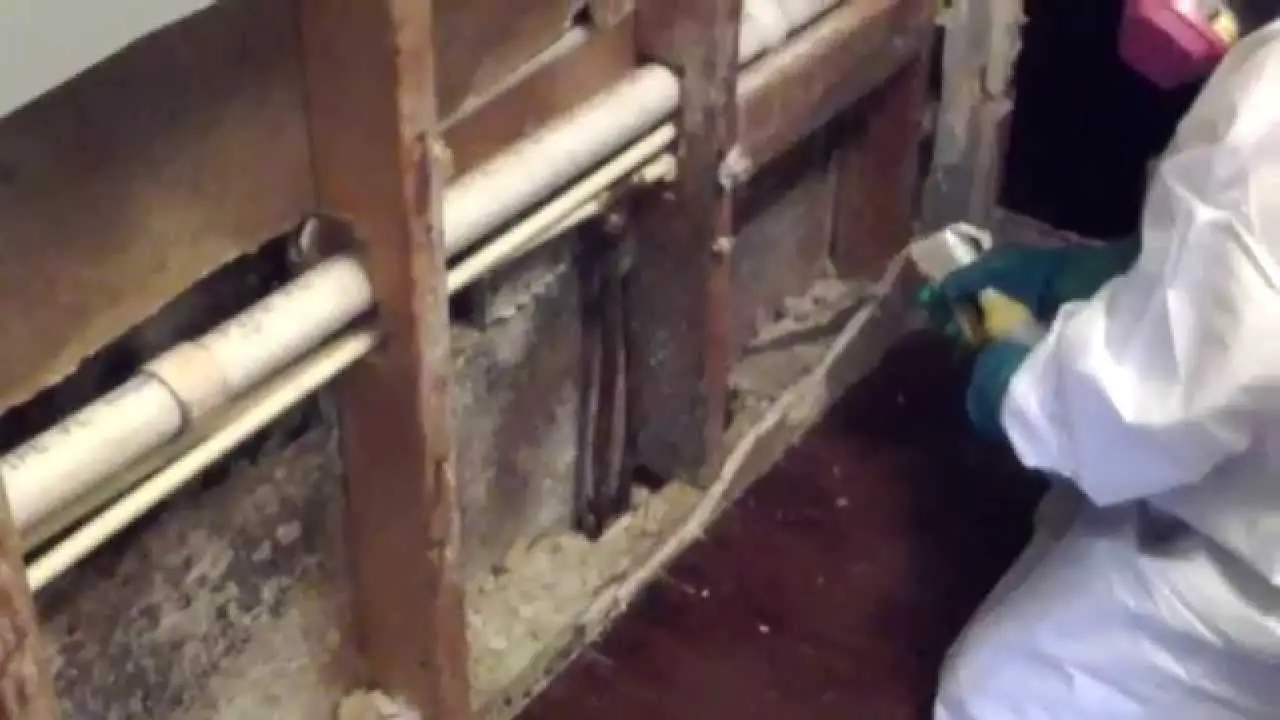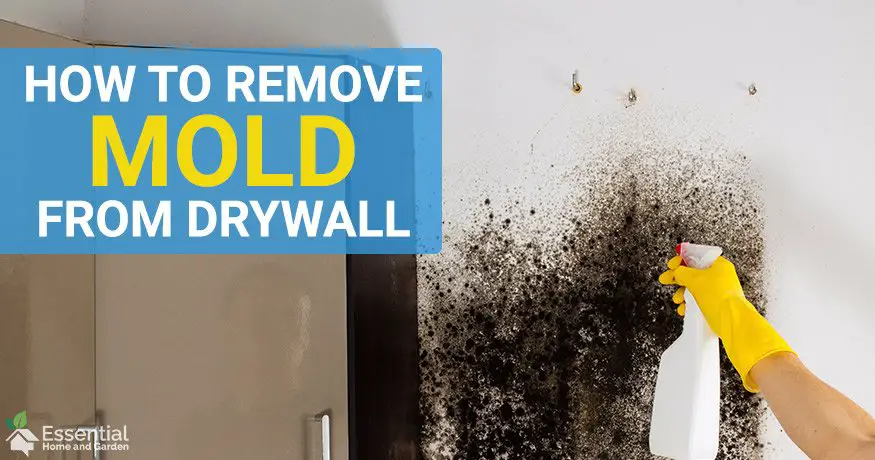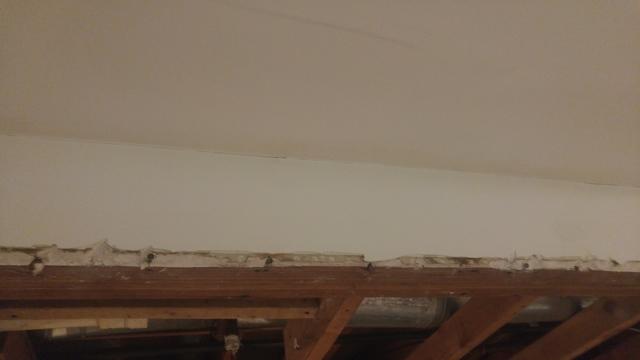What Is The Best Way To Get Rid Of Mold
Trying to get rid of mold without proper knowledge or without a professionals help may aggravate the situation or result in even more significant problems than the mold itself.
To get rid of mold completely and prevent mold regrowth, you have to determine the type of mold you are dealing with, the extent of growth, and the root cause of the problem. You have to find the best method to remove the mold, and sometimes this may involve removing the moldy surface completely. You also need to find and repair the source of moisture so mold does not grow again.
Natural ways of removing molds are best advised since most cleaning agents like bleach only remove the mold on the surface without getting to the roots. Also, some of these cleaning products have chemicals that can be toxic to humans.
Remove Mold From Tile Walls
One of the most common places you will find black mold is on the tiles and grout in bathrooms, kitchens and the laundry room. The good news is that tile is a non-porous surface, so it is one of the easiest places for removing it. The grout, if it has been sealed, cleaning will be much easier.If the grout is unsealed, it can be removed with cleaning, but it just requires a little more elbow grease than if it had been sealed.
Ammonia Can Kill Mold As Well
Ammonia should be considered an option of last resort if the mold is on your drywall.
It is a rather toxic chemical and it doesnt absorb into the drywall very well.
Never use ammonia on a wall that youve already cleaned with bleach because the combination of these two chemicals creates a gas that is toxic.
Always use clear ammonia if this is the method that you prefer.
Read Also: How To Tell If It’s Mold Or Mildew
Black Mold Inside Of The Drywall
Mold inside of the drywall will require a larger cleanup effort and removal of small parts of the drywall itself. Begin by wearing protective gear like a respirator, goggles and latex gloves and seal off the area using plastic. This will prevent the spores from spreading.
- Step 1: Place an air scrubber near the affected area to filter the air while you work.
- Step 2: Next, use a hepa vacuum on the surface of the drywall to contain spores, mycelium and mycotoxins.
- Step 3: After this, use the glove box removal method, which requires you to cut a box of plastic thats four inches longer and wider than the affected area.
- Step 4: Use spray adhesive to apply the plastic box over the moldy drywall. This keeps the mold from entering the air when you begin to cut the drywall.
- Step 5: After this, use a razor to cut the sealed moldy drywall away from the wall, carefully placing it into a garbage bag thats then sealed.
How To Clean And Disinfect

Cleaning and disinfecting the area after you remove the mold is important to make sure all spores are removed. If the area only affected the outside of the drywall, allowing a bleach mixture to sit on the surface for fifteen minutes and wiping down with water is sufficient.
If you needed to remove drywall to get rid of the mold, extra steps should be taken. First, wipe benefact antimicrobial on all of the unaffected drywall near the area. Use a HEPA vacuum on the unaffected areas as well to remove any spores that may be clinging. Youll also need to HEPA vacuum the entire area you contained, including floors, to make sure no spores get into other areas of the home.
You May Like: How To Make My Own Molds
Removing Mold From Different Surfaces
Once the root cause of the mold has been dealt with, its time to address the visible mold itself. Often the infestation is worse than can be seen with the naked eye, so its important to do more than wipe mold off surfaces and hope for the best. The mold you see is the spores or fruiting body of the fungus, but often the hidden roots survive a first attempt at removal and the mold comes back. Heres how to remove mold for good, wherever you find it in your property.
Before you start: Make sure to ventilate the work area properly, and wear appropriate personal protective equipment to protect against mold spores that will be disturbed when you begin working. Gloves, safety glasses, and an N95 or better mask are all essential. Wear a long sleeved shirt and pants to avoid getting spores on your skin. Try to close off the area from other rooms to prevent spores from spreading throughout your home, and consider renting a HEPA air filter.
Pro Tip: The EPA recommends only removing mold yourself if it covers an area less than 10 square feet. Any larger than that and you need to call in the pros.
Removing Mold From Wallpaper
Use the natural mold remover spray on finished, painted, or wallpapered surfaces. Spray the area well, then immediately scrub it with a clean cloth or brush to remove the surface layer of mold. Then lightly respray the area, using only enough to dampen the spot you dont want it dripping. Wait 10 minutes and wipe it with a clean, fresh cloth. Let it dry overnight without rinsing the remaining acetic acid from the vinegar will work overnight to finish killing mold you cant see.
Also Check: How To Clean Mold Off Canvas
Identify The Mold Affected Surfaces
Keep in mind, that treating all of your mold growth at once will help to ensure that the mold doesnt begin to spread again once youre finished. Because If you have mold in one place, theres a good chance you have it someplace else.;
For this step, place a small piece of painters tape near but not on, each mold spot you locate. This will help you quickly identify them later when your removing mold in your house.
If your mold problems are on the Outside of your house See our article on the Best Vinyl Siding Cleaner you can buy.
How To Clean Mold From Walls
Hiring a professional is recommended. Many people are tempted to use bleach to clean black mold from their walls, but this can cause a variety of problems. Bleach often removes the color of mold, making it almost invisible. While the walls may look clean, they are still moldy and can cause health issues.
You May Like: Do Water Filters Remove Mold
How To Get Rid Of Mold In A Basement
Mold needs damp surfaces and organic matter two things most basements have in abundance. If your basement isnt finished, or is rarely used, mold can be especially problematic. The first thing you should do is try to remove as much moisture as possible and prevent it from building up again. That means checking on seals, insulating pipes, and fixing leaks. Consider running a dehumidifier or fan on a regular basis to keep the air moving and prevent condensation from forming, and dont overlook the importance of knowing whats going on. Checking on the condition of a basement and looking for mold growth, especially in the corners of the walls and floor, will help you stay on top of any problems.
Seal Moldy Areas After They Dry
- Set out dehumidifiers and new fans to dry the now-cleaned areas for at least three days, then check them by sight and smell for mold.
- Pro tip: If you discover more mold, clean again with bleach for mold remediation.
Recommended Reading: What Causes Mold On Ceiling In Bathroom
Why Black Mold Loves To Grow On Drywall And How To Remove It
Drywall is a wonderful building material.; Its light, cheap, and easy. Throw up some drywall and youve got an instant wall in minutes.; Black mold loves growing on drywall because it is basically a giant food source. Made up of gypsum encased in two layers of soft paper, black mold feeds on the paper as a food source.;;
Also, drywall; soaks up water like a sponge, stays wet for long periods of time, and is difficult to properly dry out.; When drywall gets wet, mold usually grows on both sides of the drywall the side you can see, and the backside thats behind the wall that you cant see.; Simply cleaning the mold off of the side you can see is not enough. Youve got to get to both sides of the drywall.
Outside of a surface mold from humidity scenario, the best strategy for removing black mold from drywall is simply to cut out the impacted drywall and replace it with new. Dont waste your time trying to clean it.; Its best to cut it out, bag it up, and throw it away.
B Health Problems Caused By Mold

Mold infestation at home may put you and your family at risk. Its presence is often linked to several health problems, especially respiratory diseases and allergic symptoms. Black mold, in particular, is considered the most harmful type due to its active production of mycotoxins.
Sneezing, coughing, and sore throat are some early signs of health problems caused by mold. It can be worsened by some allergic symptoms, including rashes and hives on the skin as well as itchy and watery eyes. In more serious cases, other respiratory problems such as asthma, pneumonia, bronchitis, and sinus infection may also appear.
Moreover, the infestation of black mold on walls for a long period may damage the internal organs and suppress the immune system. If you have pets at home, this health danger can happen to your pet as well.
Read also:How Do You Know You Have Mold exposure;
Read Also: How To Tell If You Have Toxic Mold
Bleach Can Contribute To Further Mold Growth
Bleach is made up of about 90 percent water. Moreover, since molds thrive with moisture, spraying bleach on mold can contribute to further mold growth, especially on porous surfaces.
Once you apply bleach to mold on a porous surface, the chlorine content of the beach dries up almost immediately, leaving behind the water content to be absorbed into the wood or any other absorbent material. The water travels down to the root of the mold and helps it thrive. This is why mold problems often become worse a few days after bleach is applied.
Applying bleach on mold may even cause mold to grow in surrounding areas that were previously unaffected.
Clean Walls Clean Home
If you notice signs of mold growth on the walls of your home, youll need to take action before it spreads. It has the potential to cause health issues and structural problems to your property.
The most important thing to do is to fix the source of the problem to prevent mold growth. Then, depending on the size of the affected area, you can either clean the mold yourself or hire a professional.
Removing small patches of mold yourself is fairly easy. You can use readily available products such as borax, vinegar, baking soda, tea tree oil, bleach, and hydrogen peroxide. But, if mold covers a substantial area of a wall, you should seek expert help immediately.
About the Author
You May Like: How To Remove Mold From Vinyl Seats
When To Call A Professional To Get Rid Of Mold In Your Basement
Most basement mold cases are easy to tackle with the methods discussed in this guide, but major problems like hidden moisture leaks, floods, or ruptured pipes can lead to an explosion of mold growth in materials that have to be replaced. When you experience widespread mold, the job is better left to a mold remediation specialist.
Companies that maintain an American Council for Accredited Certification mold certification have the qualifications to safely remove moldy material and remediate mold on surfaces that cannot be replaced. Many of these businesses also specialize in basement encapsulation to prevent further problems from mold in basement areas.
Bleach Is Ineffective In The Long Run
In the long run, bleach only helps you mask the mold for a short period. After you have applied bleach to a porous surface, the molds dark green color is removed, and your wall returns to its bright colors. However, the roots of the molds which have reached deep into the insides continue to grow. Also, bleach does not stop harmful mold spores from spreading within the house.
In the long run, you should call an expert to look into any mold problem you have. Cleaning mold is not enough to eliminate their harmful effects because, even when molds are dead, they can still produce toxic spores. Molds have to be removed entirely, and there are different procedures for doing this depending on the type of surface on which the mold has occurred. Air quality also needs to be returned to healthy levels. To achieve these, you should let a certified mold remediation specialist handle any mold problem you have in your home.
You May Like: Is It Bad To Breathe In Mold
Quickly Stop The Source Of Moisture To Prevent Mold From Growing Further
Depending on the problem, you may have to perform significant repairs to stop the moisture. If its a leaky pipe, condensation in your HVAC system, or a crack in a doorway or window, make sure to either repair or have a professional repair it ASAP. If there is a moisture problem from your basement walls, run a dehumidifier to dry excess humidity.
Remove Mold From Building Materials
Once you have the right safety protection in place, you can go ahead and remove the flooring, drywall or other material that has become infested with mold. Go slow, and be careful not to kick up too much dust, as the dust can carry spores with it. Also, be sure that you have a safe and environmentally friendly way of disposing of the material you remove.
Recommended Reading: Can Black Mold Cause Irregular Heartbeat
How To Kill Mold With Vinegar
This article was co-authored by . Marcus is the owner of Maid Easy, a local residential cleaning company in Phoenix, Arizona. His cleaning roots date back to his grandmother who cleaned homes for valley residents in the 60s through the 70s. After working in tech for over a decade, he came back to the cleaning industry and opened Maid Easy to pass his familys tried and true methods to home dwellers across the Phoenix Metro Area.wikiHow marks an article as reader-approved once it receives enough positive feedback. In this case, 96% of readers who voted found the article helpful, earning it our reader-approved status. This article has been viewed 505,760 times.
Black mold, or Stachybotrys Chartarum, can be unsightly and can also pose a health hazard in your home. Large mold problems should be handled professionally using the necessary cleansers to rid your home of mold. Smaller mold removal projects may be able to be tackled organically using plain distilled white vinegar.
Black Mold On Top Of The Drywall Paint

If the mold is on top of the paint, removal is simple.
- Step 1: While wearing gloves and a respirator to protect you from spores, use plastic to cover the floor.
- Step 2: Make a cleaning solution with half a cup of bleach to one gallon of water.
- Step 3: Apply this solution to the mildew and let it sit for at least fifteen minutes.
- Step 4: Next, wash the area with a small amount of dishwashing liquid and clean water, then rinse with water and dry completely. All signs of the mold should be gone.
Also Check: How To Kill Mold In My Basement
Mold On Drywall Inbasement
Blackmold on surfaces is usually;caused by moisture damage. It appears on walls,ceilings, and even floors where moisture is not properly managed, particularlyin your basement. Mold may also occur in other humid or damp areas of a housesuch as your bathroom walls if the air circulation is not sufficient.
Is Bleach The Best Thing To Clean Mold Off Walls
Related Articles
Mold is not only unsightly, it’s dangerous, and some people are allergic to almost all varieties. Some species of black mold are toxic for everyone. Removing mold from walls is easier when the mold is growing on a non-porous surface, such as tile, than when it’s growing on a porous one, such as drywall. In both cases, though, you need to kill the mold, and bleaching it isn’t always the best way to do that.
You May Like: Does Vinegar Get Rid Of Black Mold
Never Use Bleach To Treat Clean Or Kill Mold Read Why
The first thing that comes to mind when you notice you have mold in the house is how to get rid of it. For most homeowners, bleach seems to be the answer to all of their mold problems. It is easily accessible and visibly removes the mold once you apply it. However, is bleach really effective in mold remediation? Should you use bleach to clean mold at all?
This article provides the answer to these questions and explains why you should never consider using bleach in cleaning mold.
- Does bleach really kill Mold?
- Should you use bleach to clean mold at all?
- What is the best way to get rid of mold?
Let us dive straight into these points.
